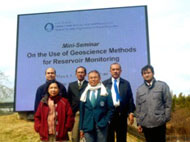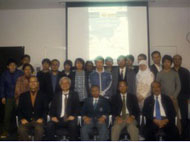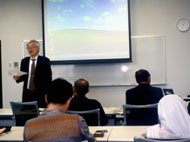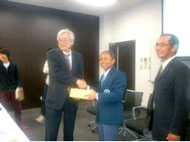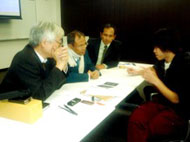Events
On the use of geoscience methods for Reservoir Monitoring
Date: March 3, 2010
Venue: Room 152 (C1), Katsura Campus, Kyoto University
Organized by:
Kyoto University Global COE Program "Global Center for Education and Research on Human Security Engineering for Asian Megacities"
Number of attendants: 25
Mini-Seminor Information
Report 092
Outline
The seminar of the Global COE program "Global Center for Education and Research on Human Security Engineering for Asian Megacities" was held in Room 152, Katsura Campus C Cluster, Kyoto University on March 3rd, 2010. This seminar was conducted in conjunction with the KU - JICA Joint Symposium on Human Security Engineering, Human Security and Related Capacity Development, which had been held in Tokyo on March 1st and 2nd 2010. The purpose of the seminar is to address and to disseminate recent research programs relating to preparation of future research project of CCS-EOR (Carbon Capture and Storage during Enhance Oil Recovery), which has a strong relationship to human security engineering issues.
Report
In this seminar, all of nine (9) presenters come mostly from Kyoto University and Institut Teknologi Bandung. One presenter comes from Pertamina EPTC (Exploration and Production Technology Center). Pertamina is national oil and gas company in Indonesia. There were 2 keynote speakers, given by Prof. Matsuoka and Prof. Santoso. Before Prof. Matsuoka started with his keynote presentation, he opened the seminar with welcoming speech and mentioned about the importance of geosciences aspects in the Human Security Engineering issues. He gave brief review about the importance of reservoir monitoring activities, especially with the need of CCS-EOR (Carbon Capture & Storage during Enhance Oil Recovery) and human security issues in Asia, particularly Indonesia.
The first keynote speaker was Prof. Matsuoka, who gave a presentation with its title: "Application of microtremor method for exploration and engineering purposes". He explained about this relatively new method in geophysics, especially its ability in determining S-wave velocity of near subsurface structure indirectly. In the second keynote presentation, Prof. Santoso mentioned about the challenge of geophysical technology for human survival from environmental problems. He gave some human related problems examples in Indonesia and the contribution of geosciences so far, in order to overcome those problems.
The next presenter is Dr. Wawan Gunawan A. Kadir. He explained about the application of 4D gravity survey on multi layers hydrocarbon reservoirs injection to maintain oil production. In his presentation, he showed application of 4D gravity monitoring in several oil and gas fields in Indonesia. Since the cost of this kind of survey is cheaper than other methods, its application is accepted by many oil companies in Indonesia and worldwide.
The next presentation, given by Shohei Minato is very interesting topic, since he talked about crosshole seismic survey without borehole sources, which is a very clever idea in implementing seismic interferometry method for shallow prospecting. In his presentation, the subsurface layering between 2 (two) boreholes can be produced. This cheaper method can be served as alternative of existing VSP method, which is very popular in the oil and gas industries.
Dina A. Sarsito's presentation is related to land subsidence studies in some urban areas of Indonesia using geodetic methods, including in Jakarta, Bandung and Semarang. The causes of land subsidence could be due to groundwater extraction, induction by the load of construction, natural consolidation of alluvium soil, or because of tectonic activities. So far, her group can monitor the rate of subsidence from sequence monitoring observations. In the future, the specific subsidence caused will be known by analyzing the existing monitoring data that is combined with other geosciences data.
Mokhamad Yusup Nur Khakim gave a presentation about INSAR measurement and its inversion for steam assisted gravity drainage (SAGD) project monitoring. He showed that the surface deformation due to gas injection into reservoir can be monitored by the INSAR data that are acquired periodically. He introduced an inversion of INSAR data, in which he can estimate the change of displacement in subsurface in a certain time. This information is very important in order to make sure that the injected gas into subsurface is already inside the correct target.
Dr. Eko Widianto, a senior researcher a Pertamina EPTC, presented a talk titled "Paradigm shift of gravity data utilization in oil and gas industries". Since he has been working for oil and gas industry for almost 30 years, his presentation is focused based on his experiences in the industry, especially with the usage of gravity method. His presentation began with the short explanation of classical gravity method applications for exploration and is ended with the advanced techniques, such as 4D microgravity method, in order to delineate and monitor the fluids and hydrocarbon movement during enhance oil recovery (EOR). This technique is a quite popular method in Indonesia, and could act as alternative of 4D seismic technique, currently it is still more expensive method.
The next presenter is Reona Masui, a former BSc student who spent his B.Sc research mostly at Geo-Management, Environment and Resources System Engineering Laboratory – Kyoto University. He explained about the application of mobile MEMS gravity-meter in the exploration of hydrothermal deposit, which is a synthetic case study. His topic uses a new invention of gravity measurement technique, since MEMS gravity-meter is still not available in the market. He tested the sensitivity of MEMS-gravity-meter on a giant wheel in the entertainment park in Tokyo. From his tests, he reported that the accuracy of MEMS gravity-meter is around 0.3 mgal, and it is still not appropriate to be used for explorations. In the near future, a better accuracy of MEMS-gravity-meter will be produced.
The last presenter is Dr. Mohammad Rachmat Sule, a post-doc researcher at the Geo-Management, Environment and Resources System Engineering Laboratory – Kyoto University and lecturer at Institut Teknologi Bandung. His presentation is about a relatively new imaging method called Common Reflection Surface Stack (CRS-Stack) method, which has been applied to several reflection seismic data obtained from oil fields in Indonesia. He showed several significant improvements on the seismic images; especially the reflectors are now more continuous. He showed that this technique is very useful to process the seismic data with complex geological structures. At the end of his presentation, he explained the recent development of user-friendly CRS-Stack software that has been built in Institut Teknologi Bandung.
The seminar ended at 18:15, or more than 1 hour from the planned before. The audients were very enthusiast until the end of seminar. Even, some students were taking opportunities to discuss about the presentation materials in more details.
